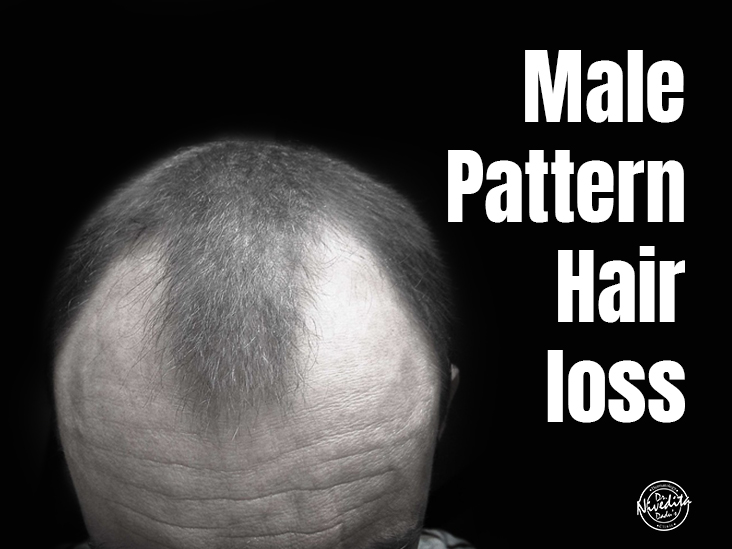Male pattern hair loss or Male pattern baldness is a natural process that most men tend to witness with age. However, it can be very distressing and psychologically disturbing for them. In case someone experiences unexpected or sudden hair loss then immediate medical attention is required.
A normal hair loss means losing hair where it previously grew but in Male pattern hair loss it happens in a specific pattern and a certain distribution is affected. Males tend to lose hair mainly from the temple and crown area and not from the back of the head. It is majorly caused due to hormonal imbalance. Hair roots go through cycles where the shedding of hair at the end of the cycle is normal and it paves way for new hair. As a normal cycle, 50-100 hair shedding in a day is normal. But in male pattern hair loss, roots are susceptible to testosterone and hence, lead to more than normal hair shedding in a day. Also, there is reduced hair growth speed, and hair that is regrowing is thinner and fragile as well.
What are the causes of Male Pattern Hair Loss?
Three major factors are responsible for Male Pattern Hair Loss. These include:
-
Genetics- This is one of the main factors that contribute to hair loss. If one’s parents or family members have suffered from the same issue then they are more likely to face Male Pattern Hair (MPH) loss.
-
Age- Age plays an important role in hair loss. It has been witnessed that most of the men experience hair loss after 40-45 years of age.
-
Hormones- MPH happens when there is fluctuation in male hormone levels. Studies have shown that male pattern hair loss is associated with androgen levels as they regulate hair growth.
These factors contribute to the shrinking of the scalp hair follicles, thus making hair growth slow, and eventually, no new hair grows. The hair growth cycle begins to weaken thus producing short fine hair and eventually no hair at all. When male pattern baldness is not inherited it could be associated with a serious cause that needs attention like medications, hormonal issues, thyroid conditions, or anabolic steroids. In such cases always consult a doctor.
Who can be at risk?
Male pattern hair loss can begin in teenage years as well, but prominently it happens in adults with aging. Genetic factor has a major role play and hence if one has a family history of the same they are more likely to be affected. It can start as a single bald spot or hairline receding in the “M” shape. In most cases, it continues until most of the hair is gone.
How to prevent it?
Never forget that hair is living cells too. It also needs a good amount of oxygen, blood supply, nutrients, and vitamins for optimum growth and health. Thus a healthy diet and good lifestyle is the basic minimum requirement for the hair to grow well. Consult a dermatologist so that they can do proper investigations and accordingly add supplements to one's diet if required. Important supplements like B- Vitamins, biotin, zinc, and selenium have been proven to show improvements with hair loss. Caffeine shampoos help stimulate hair follicles thus increasing their vitality. Avoid any kind of active damage to hair, in the form of using heavy products on hair which can be toxic or avoid using an excess of hair styling equipment that can cause heat damage, coloring, etc.
Lifestyle plays an important role in preventing hair loss. So small steps like quitting smoking, doing regular exercise, and avoiding stress will help prevent excessive hair fall. Always consult a dermatologist if it persists as this might be linked to severe causes and hence needs immediate attention.
Some of the treatment options for Male Pattern Hair Loss include:
-
Oral Medications: Consult a dermatologist as they will help to identify the deficiency or cause of hair fall and prescribe oral medications. These will help combat the causes of hair loss and improve hair growth. Oral medication like finasteride also helps in slowing down hair loss by blocking the production of the male hormone responsible for hair loss. These medications should always be taken under the supervision of an expert.
-
Topical Serums: Minoxidil is one of the common topical serums that help in controlling hair fall and regrow hair.
-
Hair Growth Promoter (HGP): This is a commonly used treatment option at dermatology clinics in which natural growth factors are extracted from one’s plasma. This provides essential nutrients and helps hair growth.
-
Hair Transplant: When hair fall has reached severe stages where baldness happens then Hair transplant is the option that will help cover the visible scalp. This is a minor surgery that is done by experts to help one get their lost hair back.
It is always advisable to seek expert opinion at the early stages of hair fall to prevent it from reaching severe stages.
Stay healthy & blessed!
Related Blogs: CAUSES AND TREATMENT OF HAIR LOSS IN MEN
TYPES OF HAIR FALL AND ITS TREATMENT

